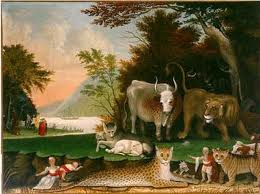We lost another silkie hen today. Nicholas said it looked as if she went to sleep beside the grain pan, but she was cold when he touched her. That is four out of six; a friend thinks, as I do, that there was something wrong genetically with that clutch. We will see if the two survivors make it through the winter. I don’t blame the breeder. It may have been something new for her, too, especially if there had been some inbreeding. Suddenly a double recessive fault can show up. I had wanted the silkies for both breeding and brooding, but if these two survive, they will not be bred.
Nicholas was melancholy about it all day, and I was subdued as well. I’ve lost a lot of young animals over the shepherding years, and I’ve lost others to storms, old age, illness and predators. It’s the way it goes on the farm. We do the best we can, but there are so many factors of uncertainty that we can never do it all perfectly.
This is what I find reassuring: The Great Creator of this universe did not intend to lose any of His creation. While the molecules and atoms of our substance go back to whence they came, the life He puts into all His creatures will return to Him. While as Christians we believe that we humans, made in His image, will have a sense of Being in life after death, we can also be assured that the wee creatures are loved by Him and are of Him. C.S. Lewis wrote of this – that the animals we called friends, who were loved by us, will have their Being in the Creator, too. So when we lose these sweet little friends, and even when the life of a farm animal is sacrificed to feed us, God is watching over them, and takes back the essence of their being.
At the last day, when our Lord shall stand upon this earth, and make it over to the perfection God intended – the new heaven above, and the new earth under our feet – all that we have known and loved, companion animals, farm animals and even the trees and flowers that enriched our lives, will be there, too.
I hope this is a comfort to others as it is to me.
A leopard with a harmless kid lay down
And not one savage beast was seen to frown
The wolf did with the lamb can dwell in peace
His grim carnivorous nature there did cease
The lion with the fatling fawn did move
And a little child was leading them in love
Long ago there was a young painter
Who had a dream that every creature came
And stood assembled by his side
And he painted the sight that had sweetened his night
For the one hundred times before he died
A kid lion and a snake and a child
Wide-eyed and formal and smiling like the sun had stopped
And time had ceased to move
And the wolf and the lamb
Came and ate from his hand
And a man-child was leading them in love
Friend have you seen all the lines and the spaces
The colors that the old painter sees
In the peaceable kingdom that shines in the faces
Of people from more gentle times than these
I find myself adrift these days
An endless maze of ends and ways
And worlds seem so crazy to be here
But look away look away
Back or forward from today
To the visions of either fools or seers
Oh my friend have you seen all the lines and the spaces
The colors that the old painter sees
In the peaceable kingdom that shines in the faces
Of people from more gentle times than these
Such a beautiful place
Full of joy full of grace
It was bathed in a saintly yellow light
To what learning to know that such things can’t be so
He could only believe that they might
Oh my friend have you seen all the lines and the spaces
The colors that the old painter sees
In the peaceable kingdom that shines in the faces
Of people from more gentle times than these
Friend have you seen all the lines and the spaces
The colors that the young painter sees
In the peaceable kingdom that shines in the faces
Of people from more gentle times than these
(Lyrics by Billy Gilman; I would have posted the link, but the publisher’s site was quite awkward and horrible with advertising things like gambling, quite out of keeping with The Quaker Painter, Edward Hicks. So, Billy, I apologize, and I hope you understand.)




![155096_463629374372_619509372_5397375_318587_n[1]](https://magdalenaperks.files.wordpress.com/2011/05/155096_463629374372_619509372_5397375_318587_n1.jpg?w=200&h=300)
















![75603_463629669372_619509372_5397382_2252200_n[1]](https://magdalenaperks.files.wordpress.com/2011/03/75603_463629669372_619509372_5397382_2252200_n1.jpg?w=225&h=300)
![16878_407666830047_605585047_10402162_7044211_n[1]](https://magdalenaperks.files.wordpress.com/2011/02/16878_407666830047_605585047_10402162_7044211_n1.jpg?w=240&h=300)
![75603_463629669372_619509372_5397382_2252200_n[1]](https://magdalenaperks.files.wordpress.com/2011/02/75603_463629669372_619509372_5397382_2252200_n1.jpg?w=225&h=300)


![155096_463629374372_619509372_5397375_318587_n[1]](https://magdalenaperks.files.wordpress.com/2011/02/155096_463629374372_619509372_5397375_318587_n1.jpg?w=225&h=300)